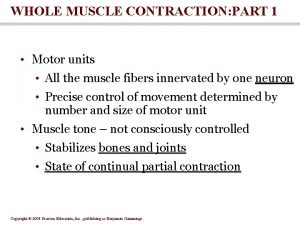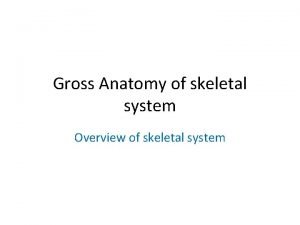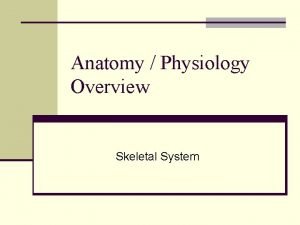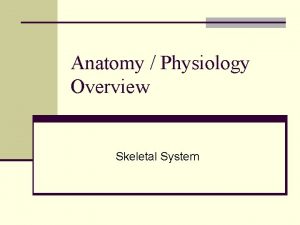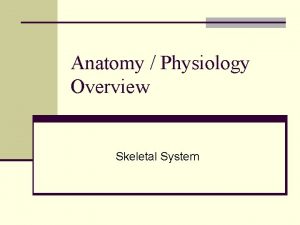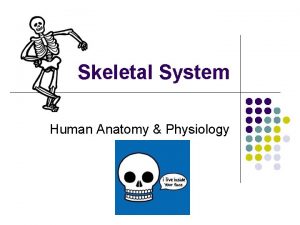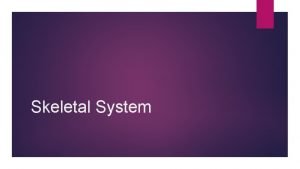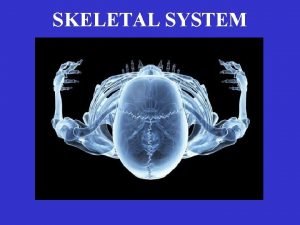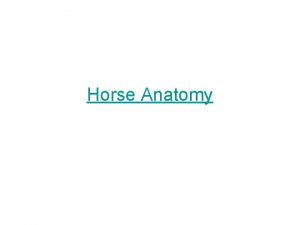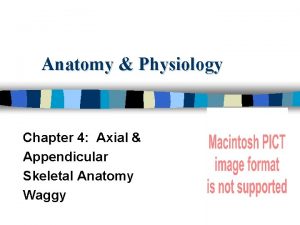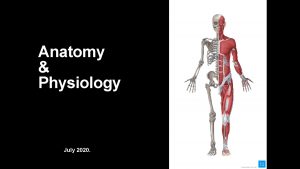Anatomy Physiology The Skeletal System Skeletal System Functions



















- Slides: 19

Anatomy & Physiology The Skeletal System

Skeletal System Functions § Support § Protection § Movement § Mineral Storage & Homeostasis § Site of Blood Cell Production § Storage of Energy

Types Of Bones § Bones can be classified on basis of shape. § Long Bones are longer than wide. (femur) § Short Bones are somewhat cubed shaped and nearly equal in length and width. (carpals) § Flat Bones are thin and comprised of two plates surrounding spongy bone. (cranial) § Irregular Bones have complex shapes. (vertebrae)

Types of Bones

Parts of Long Bones § Diaphysis – shaft or long cylinder of the bone. § Epiphysis – the ends of the bone. § Metaphysis – where diaphysis and epiphysis meet. § Articular cartilage – hyaline cartilage on the ends of the bone forming the joint.

Parts of Long Bone § Periosteum – tough outer covering on bone made of dense fibrous connective tissue. § Medullary Cavity – hollow cavity in the diaphysis which contains yellow bone marrow. § Endosteum – the lining of the medullary cavity contain osteoprogenic and osteoblasts.

Parts of a long bone

Histology of Bone § Several connective tissues make up bone. They include cartilage, dense connective, and osseous. § Bone contains large amounts of matrix, made of calcium salts and collagen fibers. The salts crystallize within a network of fibers. § Cells found within bone include osteogenic, osteoblasts, osteocytes, and osteoclasts.

Histology of Bone § Bone is not totally solid. It contains a solid region (compact bone) and a porous region (spongy bone). § The structural unit of compact bone is the Osteon or Haversian System. It contains concentric rings or layers called lamellae, a central canal, and collections of osteocytes called lacunae. § Spongy bone has network called trabeculla.



Ossification of Bone § Bone formation or Ossification begins with osteogenic cells. These cells are formed from mesenchymal connective tissue. § The osteogenic cells give rise to chondroblasts which produce cartilage and osteoblasts to form bone. § Bone formation takes place in the embryo either on a membrane or within a cartilage model.

Ossification of Bone § Intramembranous – the cranial bones and clavicles are formed by this type of bone formation. § Endochondral – all other bones are formed this way.

Endochondral Ossification

Bone Growth and Maintenance § Cartilage between the epiphysis and diaphysis the epiphyseal plate permits growth in length through adulthood. § Bone growth is under the control of Human Growth Hormone released from the pituitary gland. § Vitamin D is needed for absorption of Calcium into bone, from the GI Tract. § Ossification is complete by age 25.

Bone and Mineral Homeostasis § Bones store and release calcium and phosphate. § This process is controlled by the hormones: Calcitonin (CT), Parathyroid hormone (PTH), and Vitamin D. § PTH activates osteoclasts and decreases bone density. (reabsorption). § CT increases osteoblasts and increases bone density.

Exercise and Bone § When placed under mechanical stress bone becomes stronger. § The mechanical stresses come from muscles pulling on the bone and the force of gravity.

Aging and Bone § Aging of bone results from calcium loss from the body. § It begins after age 30 in females and accelerates at ages 4045 as estrogen levels decrease. § In males calcium loss does not occur until age 60.

Male vs. Female § Male bones are heavier and stronger than female bones. Joint surfaces are also larger. § Muscles attachments areas are larger in males. Due to larger muscle size. § The pelvic opening in females is larger to accommodate child birth. Hips are also angles wider in females.
 Pectoral girdle acetabulum
Pectoral girdle acetabulum Necessary life functions anatomy and physiology
Necessary life functions anatomy and physiology Anatomy and physiology unit 7 cardiovascular system
Anatomy and physiology unit 7 cardiovascular system Respiratory system anatomy and physiology
Respiratory system anatomy and physiology Physiology of skeletal muscle
Physiology of skeletal muscle Sally left the party to take cathy home
Sally left the party to take cathy home Upper respiratory tract labeled
Upper respiratory tract labeled Tattoo anatomy and physiology
Tattoo anatomy and physiology Anatomy science olympiad
Anatomy science olympiad Woody stem parts
Woody stem parts Bone metabolism
Bone metabolism Anatomy of an ulcer
Anatomy of an ulcer Liver hilus
Liver hilus Difference between anatomy and physiology
Difference between anatomy and physiology Hypogastric region
Hypogastric region Straw coloured fluid
Straw coloured fluid The central sulcus divides which two lobes? (figure 14-13)
The central sulcus divides which two lobes? (figure 14-13) 3 layers of muscle
3 layers of muscle Http://anatomy and physiology
Http://anatomy and physiology Waistline
Waistline




